As I was saying last time, there was a interesting news article recently. I saw it in The Telegraph myself. It concerned observations of massive early galaxies by the James Webb Space Telescope (JWST). Written by Joe Pinkstone, the article was dated 26th August 2024, and was called How scientists used black holes to solve mystery of earliest galaxies. Pinkstone told us that early galaxies had long been thought to contain relatively few stars, and so wouldn’t be particularly big or bright. However when the JWST started imaging those early galaxies, it found “seemingly enormous galaxies far exceeding what the theories had predicted”. As a result “scientists scrambled around for an answer to this paradox as the observations contradicted decades of dogma”. To illustrate the situation, the article showed a JWST image of the SMACS 0723 cluster alongside the equivalent Hubble image. The former shows a whole host of big bright galaxies, the latter does not:
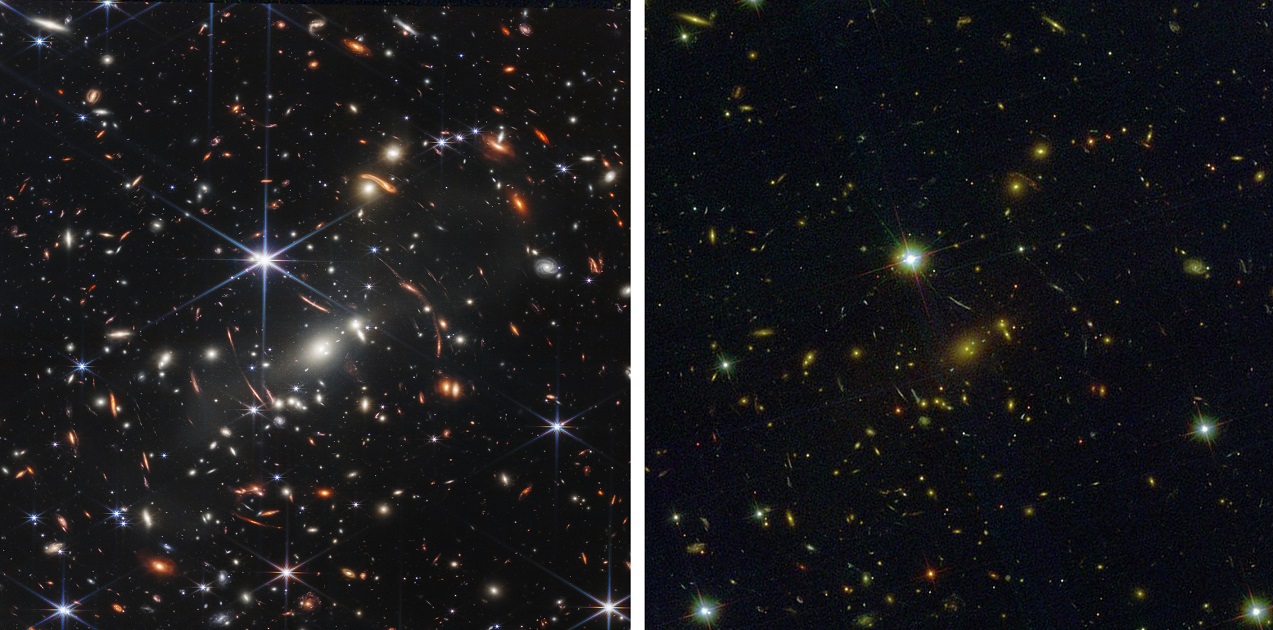 Images from The Telegraph, JWST and Hubble observations of SMACS 0723
Images from The Telegraph, JWST and Hubble observations of SMACS 0723
Pinkstone went on to say “scientists from NASA and the University of Texas have solved the riddle after discovering that hidden black holes were making the primitive galaxies seem much larger than they really are”. This meant that “the anomalously gargantuan galaxies were actually an optical illusion caused by ravenous black holes, and the laws of physics did not need rewriting”. Pinkstone was quoting Professor Steven Finkelstein and graduate student Katherine Chworowsky from the University of Texas (UT) at Austin.
Early Galaxies Were Not Too Big for Their Britches After All
Speaking of which, there’s a UT News website where you can find a more detailed article on the subject. It was written by Marc Airhart, and was also dated 26th August 2024. It’s essentially the same as NASA’s Webb press release. The title is Early Galaxies Were Not Too Big for Their Britches After All. Airhart said astronomers were expecting the JSWT images of early galaxies to show “galactic pipsqueaks”, but instead they showed the galactic equivalent of “a bevy of Olympic bodybuilders”. He said some galaxies appeared to have grown so massive so quickly that simulations could not account for them, and that some researchers had suggested that something might be wrong with the Standard Model of cosmology, which is also known as the Lambda-CDM model. Airhart told us that the evidence was provided by the JWST Cosmic Evolution Early Release Science Survey (CEERS), led by the aforementioned Professor Steven Finkelstein. He said CEERS researchers and other researchers had found evidence of fast-moving hydrogen gas, which was a signature of black hole accretion disks. Here’s a picture from the article. It’s an artist’s illustration of a black hole surrounded by gas and dust:
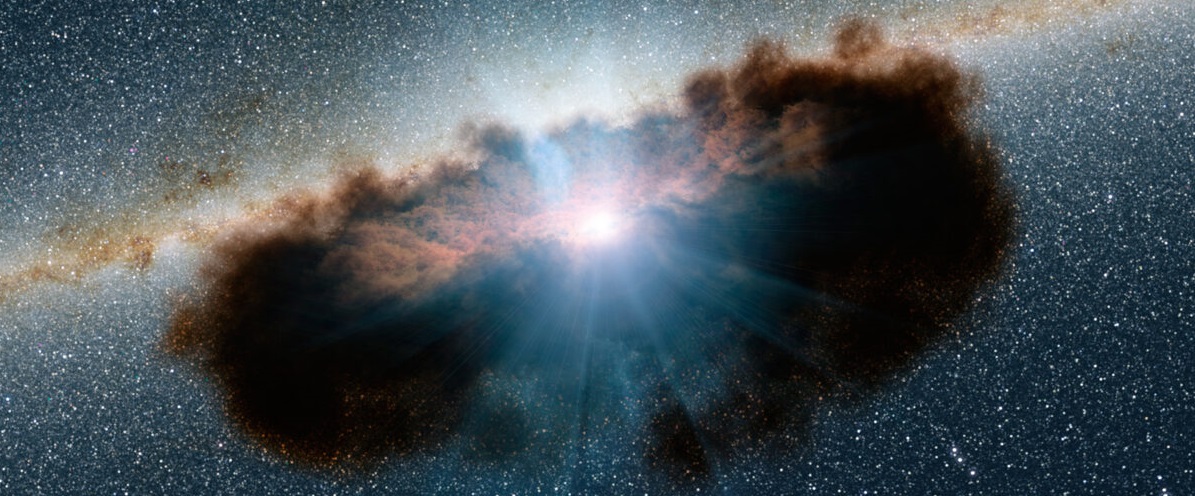 Artist illustration of a black hole surrounded by extremely thick clouds of gas and dust. Credit: NASA/JPL-Caltech
Artist illustration of a black hole surrounded by extremely thick clouds of gas and dust. Credit: NASA/JPL-Caltech
Airhart also said the black holes were thought to be in “little red dot” galaxies, but that there were still about twice as many other massive galaxies in the Webb data as expected. He quoted the aforementioned Katherine Chworowsky saying one possible reason for this might be that stars formed more quickly in the early universe than they do today. He also quoted Finkelstein saying “the bottom line is there is no crisis in terms of the standard model of cosmology”.
Evidence for a Shallow Evolution in the Volume Densities of Massive Galaxies
Airhart gave a useful link to the UT Department of Astronomy Cosmic Frontier Center website. This gives us some “guiding questions” along with “fast facts”, such as UT has had nearly 10% of all the JWST telescope time. In addition Airhart linked to the relevant paper in the Astronomical Journal. Again published on 26th August 2024, this was called Evidence for a Shallow Evolution in the Volume Densities of Massive Galaxies at z = 4–8 from CEERS. The lead author was Katherine Chworowsky, and there were 38 other authors, so an alternative name for this paper might be Chworowsky et al 2024. I’m pleased to say it’s an open access paper, so you don’t need to find it on the arXiv or elsewhere. It starts with an introduction which talks about estimating the stellar mass of a galaxy. It says this is typically inferred by modelling the ultraviolet through near-infrared spectral energy distribution, which “relies on assumptions about the galaxy’s star formation history (SFH), metal enrichment history, dust attenuation, and stellar initial mass function (IMF)”. The paper also says Hubble provided galaxy stellar mass estimates for redshifts up to z = 5, but beyond that its wavelength coverage wasn’t enough.
 Screenshot from Evidence for a Shallow Evolution in the Volume Densities of Massive Galaxies at z = 4–8 from CEERS
Screenshot from Evidence for a Shallow Evolution in the Volume Densities of Massive Galaxies at z = 4–8 from CEERS
The paper then talked about the JWST, saying it enabled a huge leap forward in both the resolution and sensitivity of infrared imaging, allowing for the measurement of accurate stellar masses out to redshifts of circa z = 10. It also said the JWST data had “begun to revolutionize our understanding of the Universe, with new discoveries answering long-standing questions in the field of extragalactic science, while also providing unexpected results and generating new questions”. On top of that it said one of the unexpected early results was an apparent excess of ultraviolet-luminous z ≳ 8 galaxies relative to many recent theoretical models.
Selection of Massive Galaxies
See section 3 on Selection of Massive Galaxies. They started with 2,357 light sources. They then split them into a z < 3.5 low redshift sample of 1,796 sources, and a z > 3.5 high redshift sample of 561 sources, which were what they were interested in. Then they removed 297 sources from the latter due to unreliable photometry, and another 3 which were oversplit*. Hence they removed 300 out of the 561 high-redshift sources leaving them with “261 sources with robust photometry which satisfied our selection”. Also see section 3.4 Additional Data and 3.4.2. Spectroscopic Redshifts. They checked the photometric redshifts using more reliable spectroscopic redshifts, obtained from the JWST MIRI, NIRSpec, and NIRCam instruments.
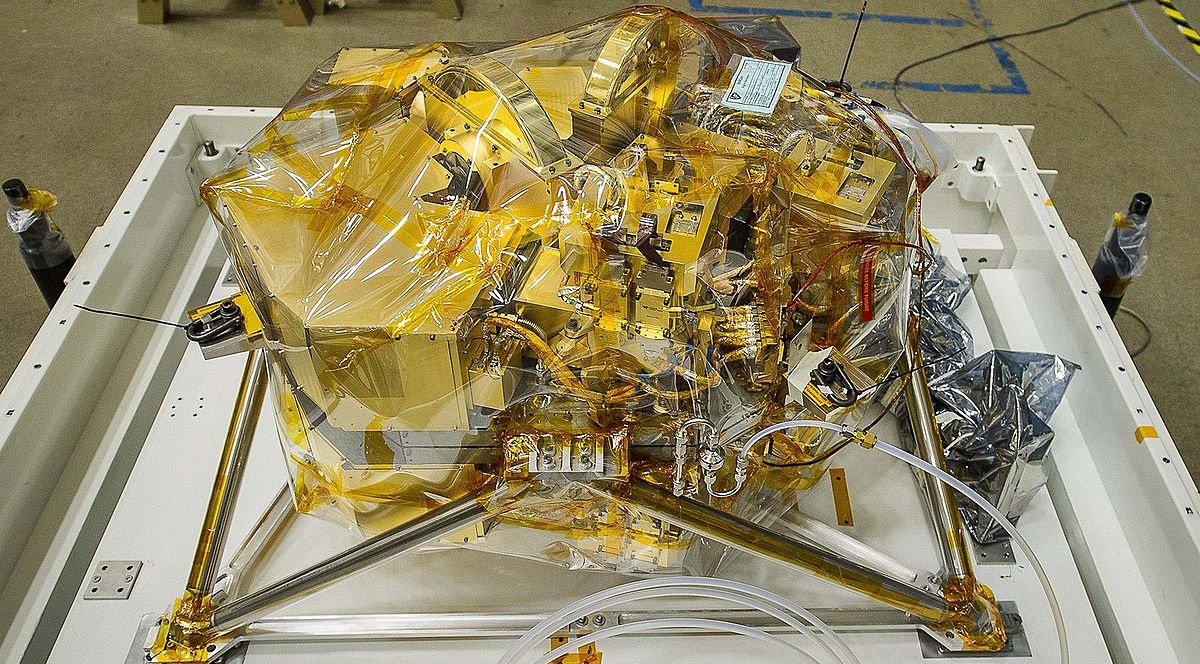 Public domain image of NIRCam, the JWST primary imager, see Wikimedia Commons
Public domain image of NIRCam, the JWST primary imager, see Wikimedia Commons
They gave their results in Table 1, which listed 120 z > 4 massive galaxies, of which 17 had a spectroscopic redshift. By and large the spectroscopic redshift was a little less than the photometric redshift, but close enough to give confidence that the photometric redshifts were largely correct. Note that all the stellar masses in Table 1 were log₁₀(M⋆/M⊙) of 10 or more. M⋆ represents the stellar mass of the galaxy, and M⊙ represents the mass of our Sun. The most massive galaxy in the list was CEERS-42006 where log₁₀(M⋆/M⊙) = 10.9. That works out at eighty billion solar masses. In 2014 the Milky Way stellar mass was said to be sixty billion. However more recent research suggests that this could be an over-estimate. Either way, these 120 early massive galaxies look to be very massive indeed.
Extremely red objects
Next see section 3.5 on Extremely Red Objects (EROs). These are the “little red dots” mentioned in the press release. They are high-redshift pointlike sources which are “blue or flat in the short-wavelength channels in JWST but show extreme reddening toward longer wavelengths”. The paper said “Barro et al. (2024) analyzed these sources and found that the most likely explanation of the photometric colors are various combinations of dust-reddened AGN with bluer stellar components”. This was a reference to a 2024 paper by Guillermo Barro and 34 other authors. It was called Extremely Red Galaxies at z = 5–9 with MIRI and NIRSpec: Dusty Galaxies or Obscured Active Galactic Nuclei? Note that the hypothesis that the EROs feature obscured AGNs, and therefore dusty supermassive black holes, came from the Barro et al paper, not from the Chworowsky et al paper. The latter also says “Indeed, early JWST observations seem to indicate that accreting supermassive black holes are relatively common at z > 5”, referring to no less than 10 previous papers published in 2023. Then it says “With only photometric colors available, it is extremely difficult to accurately determine the light contributed by the AGN component of these galaxies, making photometric stellar mass estimates for these sources extremely uncertain”. It then says they removed these sources from their sample. They found nine sources from a “color cut”, making use of F444W, a filter on the JWST NIRCam instrument. Then they removed one source because it wasn’t pointlike, and added three other pointlike sources, ending up with 11 EROs.
Cumulative Number Densities of Massive Galaxies
In section 4 the paper gave results, starting with section 4.1 Cumulative Number Densities of Massive Galaxies. This said they put the galaxies into redshift “bins” of Δz = 1. So there was a bin for galaxies with a redshift between z = 4 and z < 5, a bin for galaxies with a redshift between z = 5 and z < 6, and so on. The major takeway is given by figure 5:
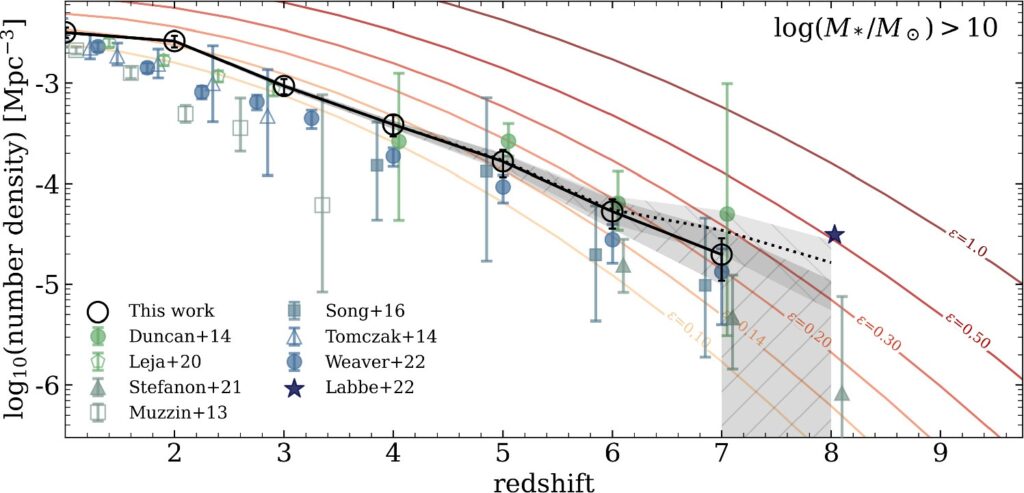 Figure 5 from Chworowsky et al 2024: The redshift evolution of massive log₁₀(M⋆/M⊙) > 10) galaxies in CEERS
Figure 5 from Chworowsky et al 2024: The redshift evolution of massive log₁₀(M⋆/M⊙) > 10) galaxies in CEERS
The black solid line shows the volume density for massive galaxies excluding the EROs. The dotted line shows the volume density for massive galaxies including the EROs. The orange–red curves show the expected volume densities for various baryon conversion efficiencies. You can see at a glance that there’s more massive early galaxies than expected, and that the 11 EROs make a difference. That’s because as stated later in section 5.3.1, at z > 7 the EROs “represent a significant portion (5/13) of massive galaxies in our sample”. That’s 5 out of 13 galaxies. Compared to the original 2,357 sources, or the 261 retained high redshift sources, it isn’t many.
Sizes of Massive Galaxies
In section 4.2 Sizes of Massive Galaxies the paper gave a size/mass distribution for redshift bins z = 4 thru z = 7, selecting 83 out of 118 sources. The paper said “Only galaxies whose best-fit models yielded magnitudes consistent with our photometry and which did not reach a constraint limit are shown”. I couldn’t see where the 120 massive galaxies in Table 1 reduced to 118 galaxies. The paper also said sizes were measured with GALFIT image processing software, but no details were given, because they “will be provided in a future paper (E. J. McGrath et al. 2024, in preparation)”. Here’s figure 6 which plots galaxy sizes:
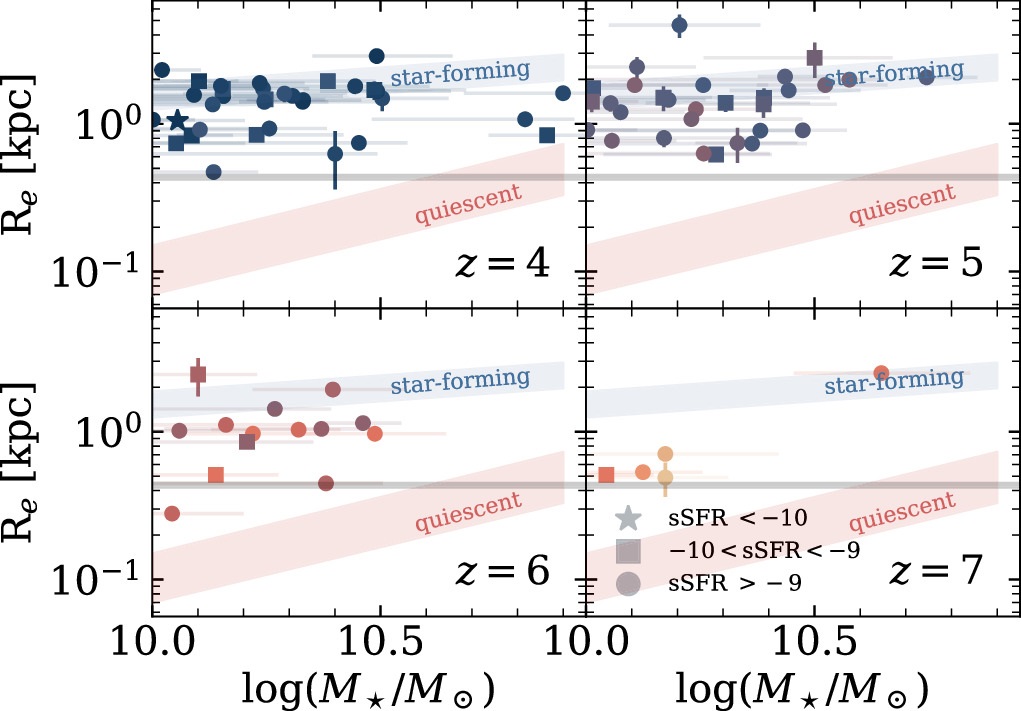 Figure 6 from Chworowsky et al 2024: the size–mass distribution of z > 4 massive galaxies
Figure 6 from Chworowsky et al 2024: the size–mass distribution of z > 4 massive galaxies
There’s really four charts shown, one for each redshift bin. The vertical axis plots galaxy size in kiloparsecs, and the horizontal axis plots the galaxy stellar mass. There isn’t much under the horizontal grey line because it shows “the size range of a point source”. By the by, the Milky Way is thought to be 26.8 kpc across. I counted 5 galaxies in the z = 7 chart, 14 galaxies in the z = 6 chart, 30 galaxies in the z = 5 chart, and 31 galaxies in the z = 4 chart. That adds up to 80 galaxies in all rather than 83, so I suspect there’s some occlusion in the charts. Generally speaking, the more massive galaxies with a lower redshift are larger in extent. This indicates galaxy growth over time, in terms of both stellar mass and spatial extent.
Formation timescales
Section 4.3 Formation Timescales talked about star formation rates (SFRs) and star formation histories (SFHs). It says this: “By studying the SFHs of massive galaxies in particular, we can attempt to understand how these galaxies manage to form surprisingly large amounts of stellar mass over relatively short timescales”. The paper said there’s perhaps a trend wherein galaxies of larger mass forming the bulk of their stars at an earlier time. However it also said the spread and errors are large, and their sample was small with only a few galaxies at z > 7, “making this relationship difficult to robustly constrain”. So they couldn’t be sure on how the galaxies had evolved over time.
Discussion
Section 5 Discussion compared the results to previous papers. In a nutshell, at lower z < 4 redshifts, they saw “slightly higher number densities that agree within the quoted uncertainties”. However at higher redshifts, their number densities of galaxies were higher than previous surveys. In addition the paper said “our results make use of deeper data covering both the rest-frame UV and optical at these redshifts”. It also said the the number density inclusive of EROs tallied with previous studies of CEERS massive galaxies by Labbé et al (2023). Section 5.2 Comparisons to Models compared the results with various galaxy formation modes. See figure 9 which omits the EROs, but still shows how observations match most models at redshifts up to z = 4, but not at higher redshifts:
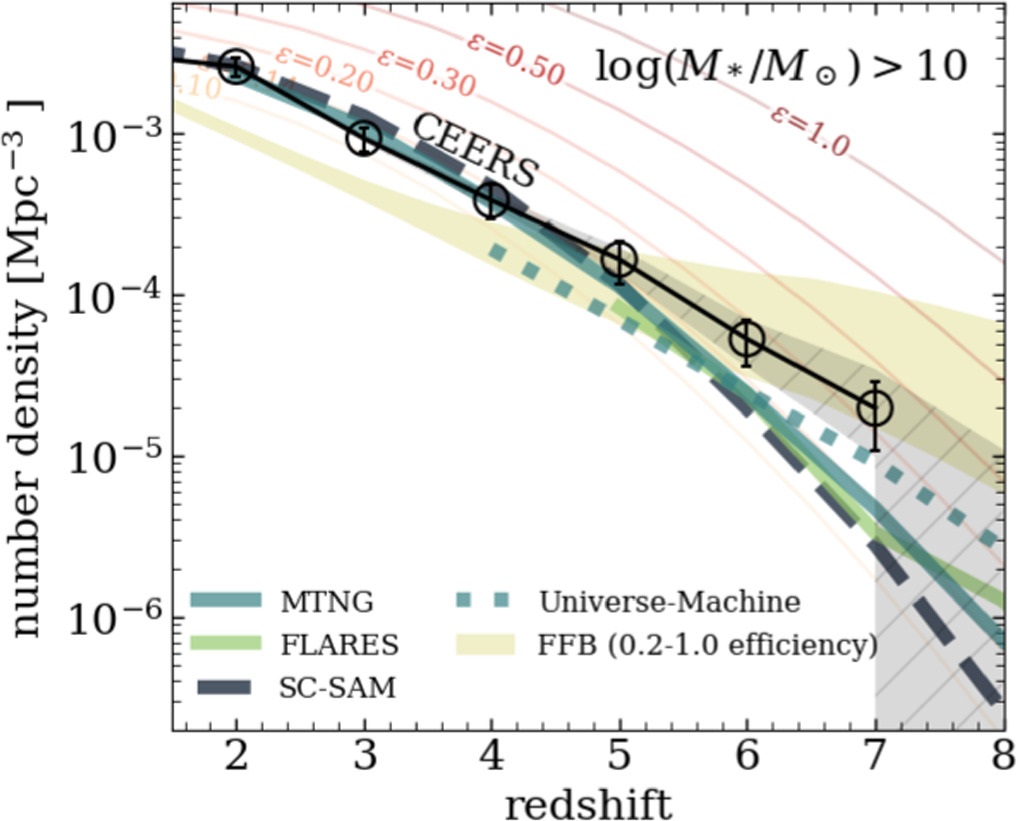 Figure 9 from Chworowsky et al 2024 : Comparison of the number density of log₁₀(M⋆/M⊙)>10 galaxies found in CEERS vs models
Figure 9 from Chworowsky et al 2024 : Comparison of the number density of log₁₀(M⋆/M⊙)>10 galaxies found in CEERS vs models
It does fit with a model called Feedback-free Starbursts (FFB) for higher redshifts, but not perfectly. The paper said “we find higher abundances of massive galaxies than that predicted by FFB”. The FFB reference links to an August 2023 paper called Efficient formation of massive galaxies at cosmic dawn by feedback-free starbursts. This said the JWST images showed “an order-of-magnitude excess in the abundance of the brightest galaxies at (partly photometric) redshifts z = 7−16 (hereafter generally 𝑧 ∼ 10) compared to the expectations based on the common wisdom of galaxy formation within the standard cosmological paradigm of ΛCDM”. Anyway, the next section of our Chworowsky et al paper was 5.3. Evolution of Massive Galaxies. This said the observations of a high abundance of bright galaxies in the early Universe “may be explained by changing the physical processes that govern the relationship between observed galaxy light and the host dark matter halo mass”. That’s making a big assumption about dark matter. The paper mentioned modifying cosmology, but moved swiftly on to two possible physical processes that could explain the excess of bright galaxies. These were 1) a higher baryon conversion efficiency at high redshifts, and 2) a changing mass-to-light ratio, wherein the ratio between luminosity and stellar mass didn’t hold at high redshifts. Two further subsections detailed these two hypotheses, but I won’t go into them.
Conclusion
The final section was Section 6 Conclusion. It gave a precit, then a conclusion in the final paragraph. It said this: “We find that the number of z > 4 massive galaxies in CEERS exceeds most theoretical predictions, particularly at redshifts above z ∼ 5”. The paper then said “our findings are entirely consistent with the ΛCDM cosmological model if we posit an increased efficiency of conversion of baryons into stars in massive dark matter halos with increasing redshift”. They also offered another possibility which was “a change to the mass-to-light ratios of galaxies’ stellar populations, e.g., due to variations in the IMF”. An IMF is an initial mass function, which reminds me of something I read.
Standard Model of Cosmology Survives JWST’s Surprising Finds
Take a look at Rebecca Boyle’s, Quanta Magazine article dated 20th January 2023. It was called Standard Model of Cosmology Survives JWST’s Surprising Finds. She quoted MIT astronomer Rohan Naidu saying the early galaxies “were just so stupidly bright, and they just stood out”. She said computer simulations of the ΛCDM model found that JWST’s early bright galaxies were an order of magnitude heavier than expected. She later said the JWST Advanced Deep Extragalactic Survey (JADES) team searched for galaxies whose infrared light cuts off at the Lyman break.
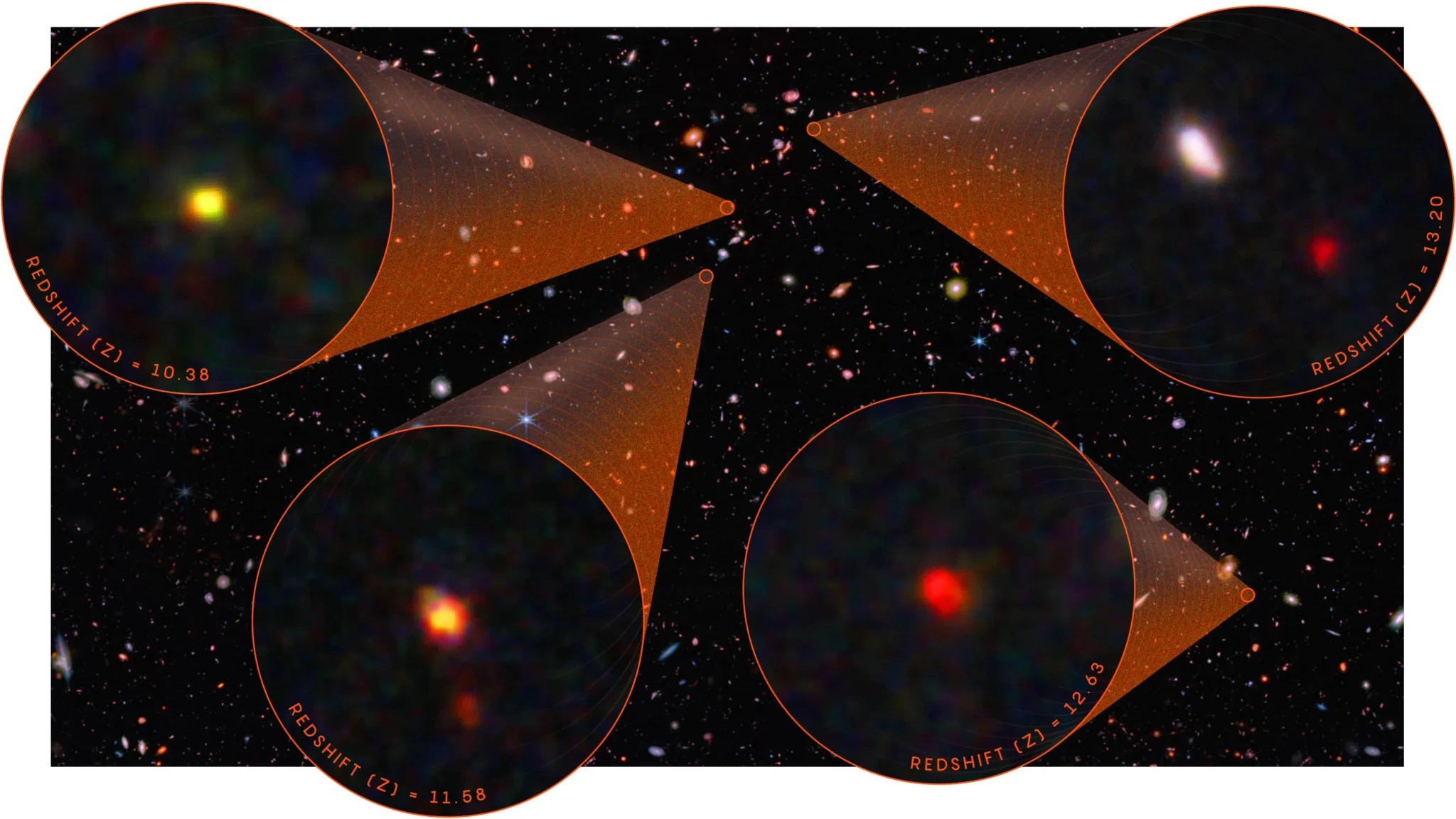 JADES image, image credit : Samuel Velasco/Quanta Magazine; source: NASA, see Quanta Magazine
JADES image, image credit : Samuel Velasco/Quanta Magazine; source: NASA, see Quanta Magazine
She said “JADES identified spectra with redshifts up to 13.2, meaning the galaxy’s light was emitted 13.4 billion years ago”. She also said a key assumption is that stars in a galaxy always form within a certain statistical range of masses, called the initial mass function (IMF), but it’s possible that the IMF was different in the early universe. However she also quoted Chris Lovell, an astrophysicist at the University of Portsmouth, saying some astronomers consider fiddling with the IMF to be “the domain of the wicked”.
Circling the wagons to defend the Standard Model of Cosmology
That’s because it would be changing the theory to match the observations. That’s not good. Nor is the fact that the August 2023 paper about the FFB model was written after the JWST observations. That’s a postdiction, a “retrofit”, as it were. It reminded me of what Oliver Consa said in something rotten in the state of QED. The JWST is the best thing going right now. There have been various articles and papers saying something is seriously amiss, and we’ve known about the Impossibly Early Galaxy Problem since at least 2015. And yet Chworowsky et al appear to be trying to sweep it under the carpet. I didn’t like that. Or the fact that there were 39 authors from 26 participating institutions. Or that it was really heavy going, and full of damn statistics. Or that the initial 2,357 light sources were whittled down to only 5 galaxies in the z = 7 chart. Or the way it didn’t say where all that AGN dust came from, or the supermassive black holes. Or the way it didn’t say anything about gamma ray bursts or quasars and galactic jets. Or the way it referred to 123 previous papers, but didn’t refer to Maisie’s galaxy, or any of the other ultra-high redshift galaxies. I felt like I was up against a tsunami of “fact-checking” arm-twisting cherry-picking coercion. I felt like this paper was circling the wagons to defend the Standard Model of Cosmology. The Webb press release quoted the aforementioned Professor Stephen Finkelstein saying this: “any time you have a theory that has stood the test of time for so long, you have to have overwhelming evidence to really throw it out. And that’s simply not the case”. Sorry Stephen, it is the case. Provided you admit the evidence. Especially because, when you dig into the history and the fundamentals, you realise that the Standard Model of Cosmology is wrong on multiple counts. You know, things like the lambda, the CDM, and the FLRW metric. Not to mention the inflation and the time dilation. I shall, of course, elaborate.
* That’s where multiple sources look like they’re part of a single large galaxy.
“Sorry Stephen, it is the case.” – The Physics Detective
Well said Sir Detective.
Thanks Dredd. I’m looking forward to writing the next article. Like the Standard Model of Particle Physics, the Standard Model of Cosmology has a whole raft of issues. It amazes me that cosmologists don’t know about them. They would if they read the Einstein digital papers.
It defies logic to build a better space telescope and then sweep all the new knowledge under the rug just to protect someone’s pet hypothesis? Not very scientific at all, is it Boss ?
Also, I’ll take the expert opinions from M.I.T. over the U. of Texass any time.
Another great expose on how human frailties constantly gum up the works and actually impedes scientific progress !
P.S. : the 6min edit box is working better on my end.
No Greg, it isn’t. The JWST is the best physics* we have at the moment. In terms of fundamental physics as opposed to things like condensed matter physics, is just about the only worthwhile physics we’ve got right now. The results have been amazing, and yet we have people clinging to a model which is wrong in multiple ways. Sadly we have a similar situation in particle physics.
.
Comment editing works for a while, then it doesn’t, et cetera. Sorry.
.
* Maybe some would say it’s cosmology as opposed to physics, but I lump ’em all in together.
It’s even tougher to get people to see that if the speed of light varies, so does the Coulomb force . The are inescapably linked by permittivity:
.
, Fr=1/4πε
.
I learn something new every day Steve!
It’s even tougher to get people to see that if the speed of light changes so does the Coulomb force. The share a common element: permitivitty.
Maybe, just maybe the early universe had stronger phi. Same mass/energy, smaller universe. Slower c. Weaker Fc, easier fusion. Thanks JWT!
Steve, c tends to zero at the event horizon of a black hole. That’s where time dilation goes infinite. The early universe has been likened to a black hole in reverse by people like Stephen Hawking. I am not a fan of Stephen Hawking. I think he got a lot of things wrong about black holes. But I don’t think he was wrong about that.
Yes, that makes sense about c approaching zero at the event horizon. I’ve read it in your writings before. Overlooked, I think, is that Fc would also have to decrease. All that glow around the event horizon could be fusion more so than friction.
You have look at this one Steve: https://physicsdetective.com/gammaraybursts/. It’s about gamma ray bursts.
You once wrote an article about the mechanical equivalent of permittivity. Were is it please?
Sorry Steve, i couldn’t find it. I talked about this in https://physicsdetective.com/dark-energy/. See the section Waves run through it. I’ll have another look in the morning. Meanwhile can I reiterate that as far as I can tell space is like some gin-clear ghostly elastic solid wherein wave speed v = √(G/ρ). That’s where G is the shear modulus and rho is the density. Only for space, we write it as c = 1/√(ε0μ0), because there’s a reciprocal in the definition of permittivity. IMHO if a seismic wave moves through the ground, the ground waves. If an ocean wave moves through the sea, the sea waves. And if an electromagnetic wave moves through space, space waves.
Anything by or about hawking gives me a headache trying to make sense of it…
Re permittivity, I think that’s the holy grail.
I see permittivity as “how easy is it to deform space”. I see permeability as “how good is space at bouncing back”.
Another big yawn in De Acme-Nobel DYN-O-MYTE Award in Physics gifted to some A.I. Grifters…….
I saw it. I was gobsmacked. It isn’t physics, and as anybody who has had a serious interaction with it knows, it isn’t even Artificial Intelligence.
Hello John. I took a brief break from my routine but I stumbled across this that really got my attention; thoughts? https://www.earth.com/news/study-dark-matter-does-not-exist-and-the-universe-is-27-billion-years-old/
Parish: I bumped into Rajendra Gupta’s paper when I was writing the above article. I like the way he entertains a variable speed of light, but not the way he doesn’t know that the speed of light varies in the room you’re in. In addition, I am not in favour of tired light. Especially because people think the ascending photon loses energy and is redshifted, when it isn’t. Especially because people think the cosmic photon loses energy and is redshifted, when it isn’t. I like the way he talks about the universe being older than 13.8 billion years, but not the way he doesn’t include time dilation. In addition, he doesn’t understand that “the energy of the gravitational field shall act gravitatively in the same way as any other kind of energy”. If he did, he wouldn’t discard dark matter and dark energy. All in all I’d say I’m surprised that his CCC-TL model got published in The Astrophysical Journal.
GRGs are fascinatingly new to myself, hope someone else may enjoy as well.
https://www.sarao.ac.za/news/the-age-of-giants-meerkat-spots-a-troublesome-cosmic-beast/